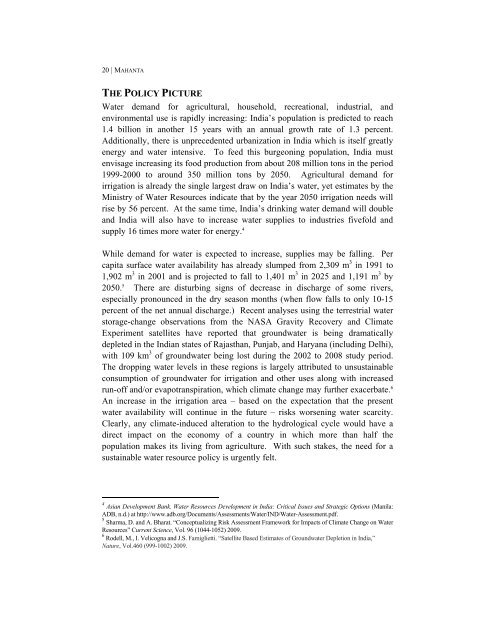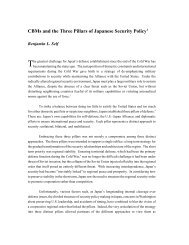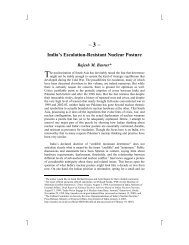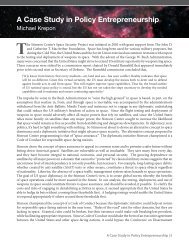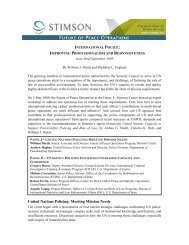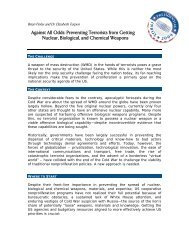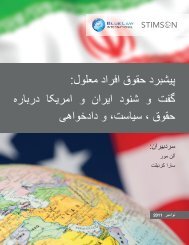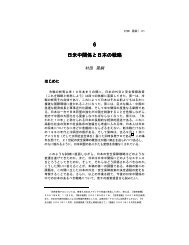Indian Climate Policy: Choices and Challenges - The Stimson Center
Indian Climate Policy: Choices and Challenges - The Stimson Center
Indian Climate Policy: Choices and Challenges - The Stimson Center
You also want an ePaper? Increase the reach of your titles
YUMPU automatically turns print PDFs into web optimized ePapers that Google loves.
20 | MAHANTA<br />
THE POLICY PICTURE<br />
Water dem<strong>and</strong> for agricultural, household, recreational, industrial, <strong>and</strong><br />
environmental use is rapidly increasing: India’s population is predicted to reach<br />
1.4 billion in another 15 years with an annual growth rate of 1.3 percent.<br />
Additionally, there is unprecedented urbanization in India which is itself greatly<br />
energy <strong>and</strong> water intensive. To feed this burgeoning population, India must<br />
envisage increasing its food production from about 208 million tons in the period<br />
1999-2000 to around 350 million tons by 2050. Agricultural dem<strong>and</strong> for<br />
irrigation is already the single largest draw on India’s water, yet estimates by the<br />
Ministry of Water Resources indicate that by the year 2050 irrigation needs will<br />
rise by 56 percent. At the same time, India’s drinking water dem<strong>and</strong> will double<br />
<strong>and</strong> India will also have to increase water supplies to industries fivefold <strong>and</strong><br />
supply 16 times more water for energy. 4<br />
While dem<strong>and</strong> for water is expected to increase, supplies may be falling. Per<br />
capita surface water availability has already slumped from 2,309 m 3 in 1991 to<br />
1,902 m 3 in 2001 <strong>and</strong> is projected to fall to 1,401 m 3 in 2025 <strong>and</strong> 1,191 m 3 by<br />
2050. 5 <strong>The</strong>re are disturbing signs of decrease in discharge of some rivers,<br />
especially pronounced in the dry season months (when flow falls to only 10-15<br />
percent of the net annual discharge.) Recent analyses using the terrestrial water<br />
storage-change observations from the NASA Gravity Recovery <strong>and</strong> <strong>Climate</strong><br />
Experiment satellites have reported that groundwater is being dramatically<br />
depleted in the <strong>Indian</strong> states of Rajasthan, Punjab, <strong>and</strong> Haryana (including Delhi),<br />
with 109 km 3 of groundwater being lost during the 2002 to 2008 study period.<br />
<strong>The</strong> dropping water levels in these regions is largely attributed to unsustainable<br />
consumption of groundwater for irrigation <strong>and</strong> other uses along with increased<br />
run-off <strong>and</strong>/or evapotranspiration, which climate change may further exacerbate. 6<br />
An increase in the irrigation area – based on the expectation that the present<br />
water availability will continue in the future – risks worsening water scarcity.<br />
Clearly, any climate-induced alteration to the hydrological cycle would have a<br />
direct impact on the economy of a country in which more than half the<br />
population makes its living from agriculture. With such stakes, the need for a<br />
sustainable water resource policy is urgently felt.<br />
4 Asian Development Bank. Water Resources Development in India: Critical Issues <strong>and</strong> Strategic Options (Manila:<br />
ADB, n.d.) at http://www.adb.org/Documents/Assessments/Water/IND/Water-Assessment.pdf.<br />
5 Sharma, D. <strong>and</strong> A. Bharat. “Conceptualizing Risk Assessment Framework for Impacts of <strong>Climate</strong> Change on Water<br />
Resources” Current Science, Vol. 96 (1044-1052) 2009.<br />
6 Rodell, M., I. Velicogna <strong>and</strong> J.S. Famiglietti. “Satellite Based Estimates of Groundwater Depletion in India,”<br />
Nature, Vol.460 (999-1002) 2009.


